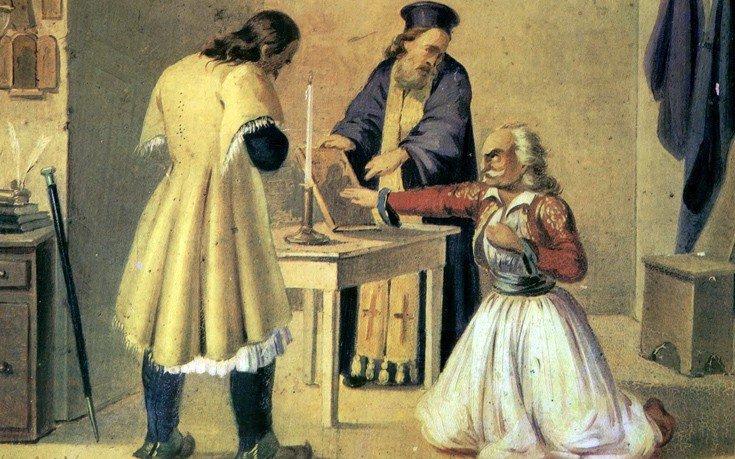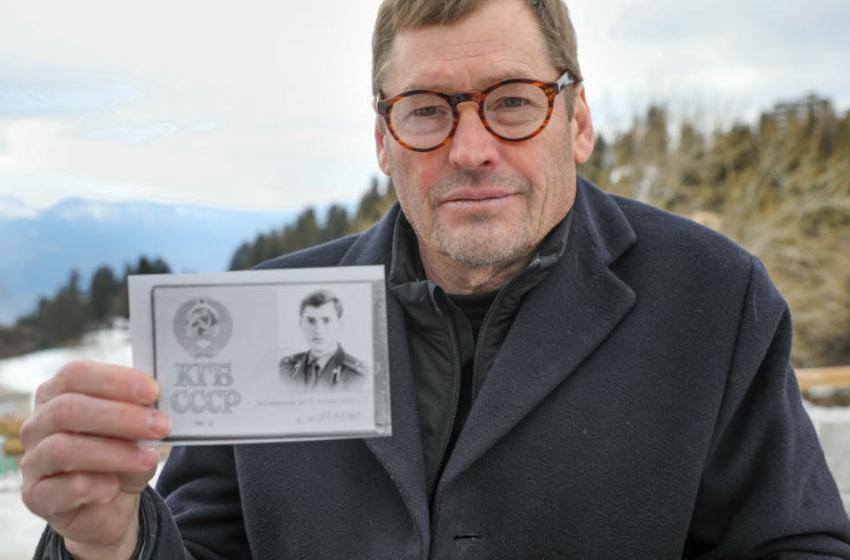A secret organization founded in 1814 in Odessa, whose purpose was to overthrow the Ottoman rule of Greece and establish an independent Greek state
The example of Rigas Velestinlis was very much in the minds of the three young Greeks, lowly members of the Greek mercantile diaspora, who in 1814 in Odessa (then in southern Russia, now in Ukraine), the centre of a thriving Greek community, founded the Filiki Etairia, or “Friendly Society.â€
Their specific aim was to lay the foundations for a coordinated, armed uprising against the Turks. The three founders—Emmanuil Xanthos, Nikolaos Skouphas, and Athanasios Tsakalov—had little vision of the shape of the independent Greece they sought beyond the liberation of the motherland.
The initiation rituals of the Filiki Etairia were strongly influenced by those of the Freemasons. There were four categories of membership, ranging from the lowly vlamis (brother) to the poimin (shepherd). Those who betrayed the conspiracy were ruthlessly dispatched. Initially the society’s attempt to recruit members throughout the Greek world met with little success, but from 1818 onward it made some headway, finding an important source of recruits in the communities of the diaspora. From the outset the leadership of the society—aware that the majority of the Greek people considered their fellow Orthodox believers, the Russians, to be their most likely liberators—misleadingly suggested that the conspiracy was backed by the Russian authorities.

Portrait of the 3 founders of Filiki Etaireia Emmanouil Xanthos, Nikolaos Skoufas and Athanasios Tsakalov. Encircling the portrait is the text "HELLENIC REPUBLIC", along with denomination "5 EURO" (all in Greek), the National Crest and the issue year "2014"
Two attempts were made to recruit Count Ioánnis KapodÃstrias—a Greek from Corfu (Kérkyra) who since 1816 had served as joint foreign minister to Tsar Alexander I of Russia and who was well versed in the ways of European diplomacy—as leader of the conspiracy. The conservative KapodÃstrias, however, was dismissive of the plot and urged the Greeks to bide their time until there was another war between the Russian and Ottoman empires, when they might hope to achieve the kind of quasi-autonomy gained by Serbia in 1813. Although he could see no future in the plans of the members of the Filiki Etairia, KapodÃstrias did not betray the secret of the conspiracy. The leadership of the conspiracy was then transferred to another Greek in the Russian service, Prince Alexander Ypsilantis, a Phanariote who held the position of aide-de-camp to Alexander but who lacked the political experience of KapodÃstrias.
Like Rigas Velestinlis, the conspirators were hoping for the support of the Romanians and the Bulgarians, but there was little enthusiasm for the project on the part of the other Balkan peoples, who were inclined to view the Greeks—with their privileged position in the Ottoman Empire and their enthusiasm for the ecclesiastical and cultural Hellenization of the other Balkan Christians—as scarcely less oppressive than the Turks.
Although unable to rely on the other Balkan peoples, the leadership of the conspiracy succeeded in exploiting the internal problems of the Ottoman Empire to its advantage. Sultan Mahmud II, who had ascended the throne in 1808, was bent on restoring the authority of the central government. In 1820, he launched an attack against Ali Paşa Tepelenë, a provincial warlord who, from his capital in Ioánnina, exercised control over large areas of mainland Greece. Although he nominally paid allegiance to the sultan, his virtual independence had for many years exasperated the Ottoman authorities. Taking advantage of the fact that large numbers of Ottoman troops were participating in the campaign against Ali Paşa, Alexander Ypsilantis launched an attack from Russian territory across the Pruth River in March 1821, invoking the glories of ancient Greece in his call to arms from Jassy (Iasi), the Moldavian capital. His campaign met little success, and he encountered no enthusiasm on the part of the supporters of Tudor Vladimirescu, who had risen against the oppression of the local Romanian boyars, or notables. Memories of Phanariote Greek oppression were altogether too vivid and recent. In June of 1821 Ypsilantis and his motley army were defeated at the battle of Drăgătsani, and Ypsilantis was forced dishonourably to flee into Habsburg territory, where he died in captivity in 1828.

Revolt in the Peloponnese
Shortly after Ypsilantis’s raid into Moldavia, scattered violent incidents coalesced into a major revolt in the Peloponnese. It is said to have begun on March 25, 1821—still celebrated as Greek Independence Day—when Germanos, archbishop of Pátrai, unfurled a Greek flag at the monastery of Ayia Lavra near Kalávrita. With atrocities being committed by both sides, the Turks, very much in a minority, were forced to retreat to their coastal fortresses. The diversion of Ottoman forces for the attack on Ali Paşa, the element of surprise, and the military and especially naval skills on which the Greeks could draw gave the Greeks an advantage in the early years of what proved to be a lengthy struggle.
The revolt caught the public’s attention in western Europe, even if in the early years the reactionary governments of post-Napoleonic Europe were not prepared to face any disturbance of the existing order. Public sympathy in western Europe was translated into more concrete expressions of support with the arrival in the Peloponnese of philhellene volunteers, the best-known of whom was the poet Lord Byron, who had traveled extensively in the Greek lands before 1821. The military contribution of the philhellenes was limited, and some became disillusioned when they discovered that Greek reality differed from the idealized vision of Periclean Athens in which they had been nurtured in their home countries. The philhellenic committees that sprang up in Europe and the United States, however, soon raised money for the prosecution of the war and the relief of its victims, such as the survivors of the great massacre on ChÃos in 1822, immortalized by the French painter Eugène Delacroix.






















